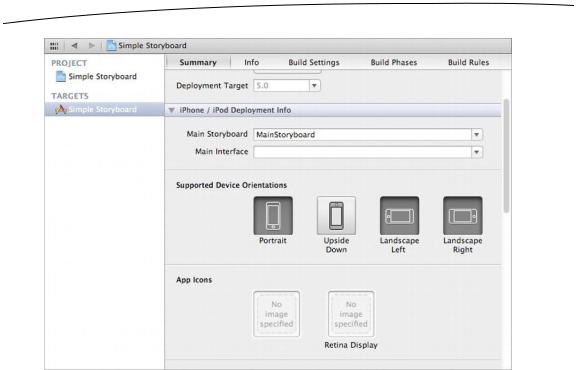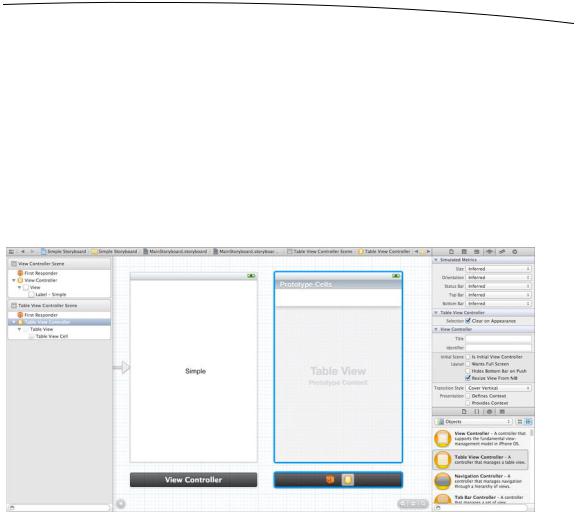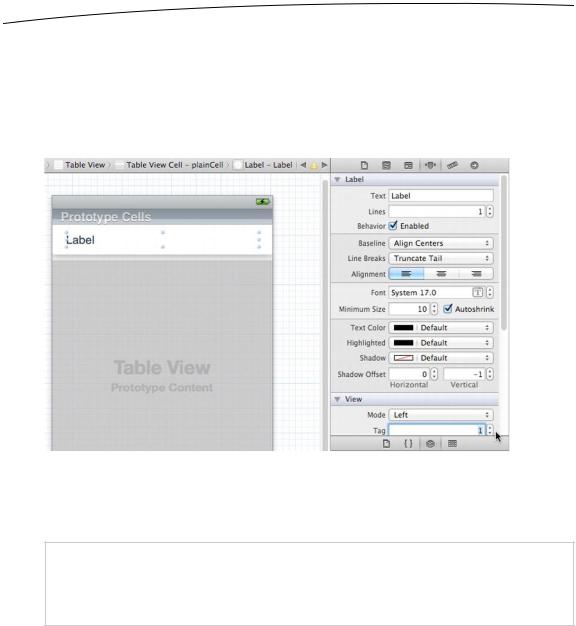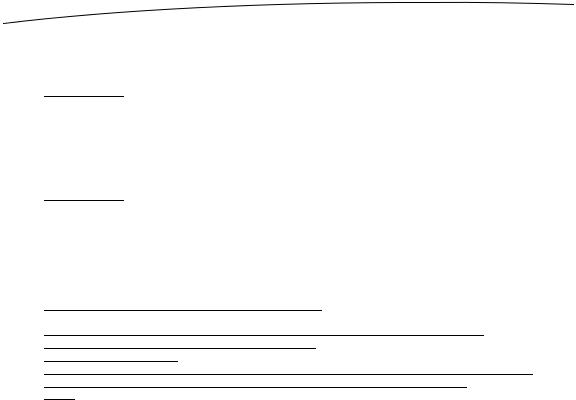
- •Contents at a Glance
- •About the Authors
- •About the Technical Reviewer
- •Acknowledgments
- •Preface
- •What This Book Is
- •What You Need
- •Developer Options
- •What You Need to Know
- •What’s Different About Coding for iOS?
- •Only One Active Application
- •Only One Window
- •Limited Access
- •Limited Response Time
- •Limited Screen Size
- •Limited System Resources
- •No Garbage Collection, but…
- •Some New Stuff
- •A Different Approach
- •What’s in This Book
- •What’s New in This Update?
- •Are You Ready?
- •Setting Up Your Project in Xcode
- •The Xcode Workspace Window
- •The Toolbar
- •The Navigator View
- •The Jump Bar
- •The Utility Pane
- •Interface Builder
- •New Compiler and Debugger
- •A Closer Look at Our Project
- •Introducing Xcode’s Interface Builder
- •What’s in the Nib File?
- •The Library
- •Adding a Label to the View
- •Changing Attributes
- •Some iPhone Polish—Finishing Touches
- •Bring It on Home
- •The Model-View-Controller Paradigm
- •Creating Our Project
- •Looking at the View Controller
- •Understanding Outlets and Actions
- •Outlets
- •Actions
- •Cleaning Up the View Controller
- •Designing the User Interface
- •Adding the Buttons and Action Method
- •Adding the Label and Outlet
- •Writing the Action Method
- •Trying It Out
- •Looking at the Application Delegate
- •Bring It on Home
- •A Screen Full of Controls
- •Active, Static, and Passive Controls
- •Creating the Application
- •Implementing the Image View and Text Fields
- •Adding the Image View
- •Resizing the Image View
- •Setting View Attributes
- •The Mode Attribute
- •Interaction Checkboxes
- •The Alpha Value
- •Background
- •Drawing Checkboxes
- •Stretching
- •Adding the Text Fields
- •Text Field Inspector Settings
- •Setting the Attributes for the Second Text Field
- •Creating and Connecting Outlets
- •Closing the Keyboard
- •Closing the Keyboard When Done Is Tapped
- •Touching the Background to Close the Keyboard
- •Adding the Slider and Label
- •Creating and Connecting the Actions and Outlets
- •Implementing the Action Method
- •Adding Two Labeled Switches
- •Connecting and Creating Outlets and Actions
- •Implementing the Switch Actions
- •Adding the Button
- •Connecting and Creating the Button Outlets and Actions
- •Implementing the Segmented Control Action
- •Implementing the Action Sheet and Alert
- •Conforming to the Action Sheet Delegate Method
- •Showing the Action Sheet
- •Spiffing Up the Button
- •Using the viewDidLoad Method
- •Control States
- •Stretchable Images
- •Crossing the Finish Line
- •The Mechanics of Autorotation
- •Points, Pixels, and the Retina Display
- •Autorotation Approaches
- •Handling Rotation Using Autosize Attributes
- •Configuring Supported Orientations
- •Specifying Rotation Support
- •Designing an Interface with Autosize Attributes
- •Using the Size Inspector’s Autosize Attributes
- •Setting the Buttons’ Autosize Attributes
- •Restructuring a View When Rotated
- •Creating and Connecting Outlets
- •Moving the Buttons on Rotation
- •Swapping Views
- •Designing the Two Views
- •Implementing the Swap
- •Changing Outlet Collections
- •Rotating Out of Here
- •Common Types of Multiview Apps
- •The Architecture of a Multiview Application
- •The Root Controller
- •Anatomy of a Content View
- •Building View Switcher
- •Creating Our View Controller and Nib Files
- •Modifying the App Delegate
- •Modifying BIDSwitchViewController.h
- •Adding a View Controller
- •Building a View with a Toolbar
- •Writing the Root View Controller
- •Implementing the Content Views
- •Animating the Transition
- •Switching Off
- •The Pickers Application
- •Delegates and Data Sources
- •Setting Up the Tab Bar Framework
- •Creating the Files
- •Adding the Root View Controller
- •Creating TabBarController.xib
- •The Initial Test Run
- •Implementing the Date Picker
- •Implementing the Single-Component Picker
- •Declaring Outlets and Actions
- •Building the View
- •Implementing the Controller As a Data Source and Delegate
- •Implementing a Multicomponent Picker
- •Declaring Outlets and Actions
- •Building the View
- •Implementing the Controller
- •Implementing Dependent Components
- •Creating a Simple Game with a Custom Picker
- •Writing the Controller Header File
- •Building the View
- •Adding Image Resources
- •Implementing the Controller
- •The spin Method
- •The viewDidLoad Method
- •Final Details
- •Linking in the Audio Toolbox Framework
- •Final Spin
- •Table View Basics
- •Table Views and Table View Cells
- •Grouped and Plain Tables
- •Implementing a Simple Table
- •Designing the View
- •Writing the Controller
- •Adding an Image
- •Using Table View Cell Styles
- •Setting the Indent Level
- •Handling Row Selection
- •Changing the Font Size and Row Height
- •Customizing Table View Cells
- •Adding Subviews to the Table View Cell
- •Creating a UITableViewCell Subclass
- •Adding New Cells
- •Implementing the Controller’s Code
- •Loading a UITableViewCell from a Nib
- •Designing the Table View Cell in Interface Builder
- •Using the New Table View Cell
- •Grouped and Indexed Sections
- •Building the View
- •Importing the Data
- •Implementing the Controller
- •Adding an Index
- •Implementing a Search Bar
- •Rethinking the Design
- •A Deep Mutable Copy
- •Updating the Controller Header File
- •Modifying the View
- •Modifying the Controller Implementation
- •Copying Data from allNames
- •Implementing the Search
- •Changes to viewDidLoad
- •Changes to Data Source Methods
- •Adding a Table View Delegate Method
- •Adding Search Bar Delegate Methods
- •Adding a Magnifying Glass to the Index
- •Adding the Special Value to the Keys Array
- •Suppressing the Section Header
- •Telling the Table View What to Do
- •Putting It All on the Table
- •Navigation Controller Basics
- •Stacky Goodness
- •A Stack of Controllers
- •Nav, a Hierarchical Application in Six Parts
- •Meet the Subcontrollers
- •The Disclosure Button View
- •The Checklist View
- •The Rows Control View
- •The Movable Rows View
- •The Deletable Rows View
- •The Editable Detail View
- •The Nav Application’s Skeleton
- •Creating the Top-Level View Controller
- •Setting Up the Navigation Controller
- •Adding the Images to the Project
- •First Subcontroller: The Disclosure Button View
- •Creating the Detail View
- •Modifying the Disclosure Button Controller
- •Adding a Disclosure Button Controller Instance
- •Second Subcontroller: The Checklist
- •Creating the Checklist View
- •Adding a Checklist Controller Instance
- •Third Subcontroller: Controls on Table Rows
- •Creating the Row Controls View
- •Adding a Rows Control Controller Instance
- •Fourth Subcontroller: Movable Rows
- •Creating the Movable Row View
- •Adding a Move Me Controller Instance
- •Fifth Subcontroller: Deletable Rows
- •Creating the Deletable Rows View
- •Adding a Delete Me Controller Instance
- •Sixth Subcontroller: An Editable Detail Pane
- •Creating the Data Model Object
- •Creating the Detail View List Controller
- •Creating the Detail View Controller
- •Adding an Editable Detail View Controller Instance
- •But There’s One More Thing. . .
- •Breaking the Tape
- •Creating a Simple Storyboard
- •Dynamic Prototype Cells
- •Dynamic Table Content, Storyboard-Style
- •Editing Prototype Cells
- •Good Old Table View Data Source
- •Will It Load?
- •Static Cells
- •Going Static
- •So Long, Good Old Table View Data Source
- •You Say Segue, I Say Segue
- •Creating Segue Navigator
- •Filling the Blank Slate
- •First Transition
- •A Slightly More Useful Task List
- •Viewing Task Details
- •Make More Segues, Please
- •Passing a Task from the List
- •Handling Task Details
- •Passing Back Details
- •Making the List Receive the Details
- •If Only We Could End with a Smooth Transition
- •Split Views and Popovers
- •Creating a SplitView Project
- •The Storyboard Defines the Structure
- •The Code Defines the Functionality
- •The App Delegate
- •The Master View Controller
- •The Detail View Controller
- •Here Come the Presidents
- •Creating Your Own Popover
- •iPad Wrap-Up
- •Getting to Know Your Settings Bundle
- •The AppSettings Application
- •Creating the Project
- •Working with the Settings Bundle
- •Adding a Settings Bundle to Our Project
- •Setting Up the Property List
- •Adding a Text Field Setting
- •Adding an Application Icon
- •Adding a Secure Text Field Setting
- •Adding a Multivalue Field
- •Adding a Toggle Switch Setting
- •Adding the Slider Setting
- •Adding Icons to the Settings Bundle
- •Adding a Child Settings View
- •Reading Settings in Our Application
- •Retrieving User Settings
- •Creating the Main View
- •Updating the Main View Controller
- •Registering Default Values
- •Changing Defaults from Our Application
- •Keeping It Real
- •Beam Me Up, Scotty
- •Your Application’s Sandbox
- •Getting the Documents Directory
- •Getting the tmp Directory
- •File-Saving Strategies
- •Single-File Persistence
- •Multiple-File Persistence
- •Using Property Lists
- •Property List Serialization
- •The First Version of the Persistence Application
- •Creating the Persistence Project
- •Designing the Persistence Application View
- •Editing the Persistence Classes
- •Archiving Model Objects
- •Conforming to NSCoding
- •Implementing NSCopying
- •Archiving and Unarchiving Data Objects
- •The Archiving Application
- •Implementing the BIDFourLines Class
- •Implementing the BIDViewController Class
- •Using iOS’s Embedded SQLite3
- •Creating or Opening the Database
- •Using Bind Variables
- •The SQLite3 Application
- •Linking to the SQLite3 Library
- •Modifying the Persistence View Controller
- •Using Core Data
- •Entities and Managed Objects
- •Key-Value Coding
- •Putting It All in Context
- •Creating New Managed Objects
- •Retrieving Managed Objects
- •The Core Data Application
- •Designing the Data Model
- •Creating the Persistence View and Controller
- •Persistence Rewarded
- •Managing Document Storage with UIDocument
- •Building TinyPix
- •Creating BIDTinyPixDocument
- •Code Master
- •Initial Storyboarding
- •Creating BIDTinyPixView
- •Storyboard Detailing
- •Adding iCloud Support
- •Creating a Provisioning Profile
- •Enabling iCloud Entitlements
- •How to Query
- •Save Where?
- •Storing Preferences on iCloud
- •What We Didn’t Cover
- •Grand Central Dispatch
- •Introducing SlowWorker
- •Threading Basics
- •Units of Work
- •GCD: Low-Level Queueing
- •Becoming a Blockhead
- •Improving SlowWorker
- •Don’t Forget That Main Thread
- •Giving Some Feedback
- •Concurrent Blocks
- •Background Processing
- •Application Life Cycle
- •State-Change Notifications
- •Creating State Lab
- •Exploring Execution States
- •Making Use of Execution State Changes
- •Handling the Inactive State
- •Handling the Background State
- •Removing Resources When Entering the Background
- •Saving State When Entering the Background
- •A Brief Journey to Yesteryear
- •Back to the Background
- •Requesting More Backgrounding Time
- •Grand Central Dispatch, Over and Out
- •Two Views of a Graphical World
- •The Quartz 2D Approach to Drawing
- •Quartz 2D’s Graphics Contexts
- •The Coordinate System
- •Specifying Colors
- •A Bit of Color Theory for Your iOS Device’s Display
- •Other Color Models
- •Color Convenience Methods
- •Drawing Images in Context
- •Drawing Shapes: Polygons, Lines, and Curves
- •The QuartzFun Application
- •Setting Up the QuartzFun Application
- •Creating a Random Color
- •Defining Application Constants
- •Implementing the QuartzFunView Skeleton
- •Creating and Connecting Outlets and Actions
- •Implementing the Action Methods
- •Adding Quartz 2D Drawing Code
- •Drawing the Line
- •Drawing the Rectangle and Ellipse
- •Drawing the Image
- •Optimizing the QuartzFun Application
- •The GLFun Application
- •Setting Up the GLFun Application
- •Creating BIDGLFunView
- •Updating BIDViewController
- •Updating the Nib
- •Finishing GLFun
- •Drawing to a Close
- •Multitouch Terminology
- •The Responder Chain
- •Responding to Events
- •Forwarding an Event: Keeping the Responder Chain Alive
- •The Multitouch Architecture
- •The Four Touch Notification Methods
- •The TouchExplorer Application
- •The Swipes Application
- •Automatic Gesture Recognition
- •Implementing Multiple Swipes
- •Detecting Multiple Taps
- •Detecting Pinches
- •Defining Custom Gestures
- •The CheckPlease Application
- •The CheckPlease Touch Methods
- •Garçon? Check, Please!
- •The Location Manager
- •Setting the Desired Accuracy
- •Setting the Distance Filter
- •Starting the Location Manager
- •Using the Location Manager Wisely
- •The Location Manager Delegate
- •Getting Location Updates
- •Getting Latitude and Longitude Using CLLocation
- •Error Notifications
- •Trying Out Core Location
- •Updating Location Manager
- •Determining Distance Traveled
- •Wherever You Go, There You Are
- •Accelerometer Physics
- •Don’t Forget Rotation
- •Core Motion and the Motion Manager
- •Event-Based Motion
- •Proactive Motion Access
- •Accelerometer Results
- •Detecting Shakes
- •Baked-In Shaking
- •Shake and Break
- •Accelerometer As Directional Controller
- •Rolling Marbles
- •Writing the Ball View
- •Calculating Ball Movement
- •Rolling On
- •Using the Image Picker and UIImagePickerController
- •Implementing the Image Picker Controller Delegate
- •Road Testing the Camera and Library
- •Designing the Interface
- •Implementing the Camera View Controller
- •It’s a Snap!
- •Localization Architecture
- •Strings Files
- •What’s in a Strings File?
- •The Localized String Macro
- •Real-World iOS: Localizing Your Application
- •Setting Up LocalizeMe
- •Trying Out LocalizeMe
- •Localizing the Nib
- •Localizing an Image
- •Generating and Localizing a Strings File
- •Localizing the App Display Name
- •Auf Wiedersehen
- •Apple’s Documentation
- •Mailing Lists
- •Discussion Forums
- •Web Sites
- •Blogs
- •Conferences
- •Follow the Authors
- •Farewell
- •Index

358 |
CHAPTER 10: Storyboards |
Figure 10-3. The summary of the Simple Storyboard target
Dynamic Prototype Cells
As you may recall from Chapter 8, iOS 5 lets you create a nib file containing a UITableViewCell and whatever objects you want the cell to contain, and use a unique identifier to register that cell with the table view. Then, at runtime, you can ask the table view to give you a cell based on an identifier, and if the identifier matches your earlier registration, that’s what you’ll get.
With storyboards, this concept is cranked up a notch. Now, instead of creating separate nib files for each type of cell, you can create them all in a single storyboard, directly inside the table view where they will be presented! Let’s see how this is done.
Dynamic Table Content, Storyboard-Style
We’re going to make a controller that displays a list of items. Depending on the content of each item, we’ll display them with a fairly plain style or with a more eye-catching style to alert the users that they need to pay special attention to the item. Just to make things concrete, let’s imagine these items are to-do list entries, and we want to alert the users to entries that are urgent. To keep things simple, we’ll use a plain UITableViewCell for each displayable cell instead of defining any cell subclasses. For more complicated displays in a real app, you would probably want to create your own cell subclasses to use here. In either case, the setup and workflow are the same.
www.it-ebooks.info

CHAPTER 10: Storyboards |
359 |
Since you’ve already made a new project and hardly changed a thing, let’s stick with our Simple Storyboard project. Make a new class in the Xcode project window. Select File
New New File…, then in the Cocoa Touch section choose UIViewController subclass, and then click Next. Name the class BIDTaskListController, and select UITableViewController from the Subclass of popup. Click to turn off the checkbox for creating a new XIB file, since we are going to work within the storyboard instead.
After the class files are created, switch back to MainStoryboard.storyboard, where we’ll put an instance of our new controller (and, of course, a view to match). Grab a Table View Controller from the object library and pull it out into the editing area, placing it to the right of the controller you started with. It should now look something like Figure 10-4. You’ll likely see a warning, complaining that “prototype table cells must have reused identifiers,” but no worries; we’ll address this soon.
Figure 10-4. The new table view controller, just to the right of the original view controller
Now we need to configure the table view controller to be an instance of our controller class, not the default UITableViewController. Select the newly inserted table view controller, making sure you’re selecting the controller itself, not the table view it contains. The easiest way to do this is to click the icon bar below the table view or to click the Table View Controller row in the dock. You’ll know you’ve got it when both the table view and the icon bar are outlined in blue. Open the identity inspector, and change the controller’s class to BIDTaskListController so that the table view knows where to get its data.
Editing Prototype Cells
You’ll see that the table view has a one-item group at the top labeled Prototype Cells. This is where you can graphically lay out cells however you like, and give them unique identifiers for later retrieval in your code.
www.it-ebooks.info

360 CHAPTER 10: Storyboards
Start by selecting the one blank cell that is already there and opening the attributes inspector. Set this cell’s Identifier to plainCell, and then drag a Label from the object library directly into the cell itself. Drag the label over near the left edge so that the blue guideline pops up, and then resize its width, dragging the right edge out toward the right edge of the cell until the blue guideline appears over there. Finally, with the label selected, use the object inspector to set its tag to 1 (see Figure 10-5). This will let us find the label from within our code.
Figure 10-5. With the label selected, we used the attributes inspector to change the label’s tag to 1. Note that the Tag field is in the View section toward the bottom of the inspector. The cursor is pointing at the field.
Now, select the table view cell itself (not the label it contains), and choose Edit Duplicate. This places a new copy of the cell directly below the original.
NOTE: Selecting the table view cell can be tricky. In the version of Xcode we used when we wrote this chapter, we needed to actually click the table cell in order to be able to duplicate it.
Selecting the cell in the dock was not enough. Likely this will change over time.
With the new cell selected, use the object inspector to set its identifier to attentionCell. Then select the new cell’s label, and use the attribute inspector to change the label’s
Text Color field to red, and set its Font to System Bold.
Now we have two prototype cells that are ready to use in this table view. Before we implement the code to populate this table, we need to make one more change to the storyboard. Remember that big, floating arrow that points to our original view? Drag that over to point to our new view instead. Save your storyboard.
www.it-ebooks.info

CHAPTER 10: Storyboards |
361 |
Good Old Table View Data Source
Head over to BIDTaskListController.m, where we’re going to add some code to populate our table. This is mostly pretty standard table view stuff that you’ve seen plenty of times before, so we’re going to whizz through it and skip explanations for all but the newest bits. Start by adding these bold lines near the top of the file:
#import "BIDTaskListController.h"
@interface BIDTaskListController ()
@property (strong, nonatomic) NSArray *tasks; @end
@implementation BIDTaskListController
@synthesize tasks;
This just sets up a property to contain a list of items we want to show.
Now, insert the following code in viewDidLoad to populate the tasks property. Note that we’ve left out the comments in this code.
- (void)viewDidLoad
{
[super viewDidLoad];
self.tasks = [NSArray arrayWithObjects: @"Walk the dog", @"URGENT:Buy milk", @"Clean hidden lair",
@"Invent miniature dolphins", @"Find new henchmen",
@"Get revenge on do-gooder heroes", @"URGENT: Fold laundry",
@"Hold entire world hostage", @"Manicure",
nil];
}
And, of course, we need to be a good citizen and clear that out when our view is no longer going to be shown:
- (void)viewDidUnload
{
[super viewDidUnload];
//Release any retained subviews of the main view.
//e.g. self.myOutlet = nil;
self.tasks = nil;
}
Now, we get to the meat of the controller, and implement the methods that give the table view some content. Start with the simple methods that tell the table view how many sections and rows there are:
www.it-ebooks.info

362 CHAPTER 10: Storyboards
- (NSInteger)numberOfSectionsInTableView:(UITableView *)tableView
{
#warning Potentially incomplete method implementation. // Return the number of sections.
return 0; return 1;
}
- (NSInteger)tableView:(UITableView *)tableView numberOfRowsInSection:(NSInteger)section
{
#warning Incomplete method implementation.
// Return the number of rows in the section. return 0;
return [tasks count];
}
Next, replace the content of the method that populates each cell:
- (UITableViewCell *)tableView:(UITableView *)tableView cellForRowAtIndexPath:(NSIndexPath *)indexPath
{
static NSString *CellIdentifier = @"Cell";
UITableViewCell *cell = [tableView dequeueReusableCellWithIdentifier: CellIdentifier];
if (cell == nil) {
cell = [[UITableViewCell alloc] initWithStyle:UITableViewCellStyleDefault reuseIdentifier:CellIdentifier];
}
NSString *identifier = nil;
NSString *task = [self.tasks objectAtIndex:indexPath.row]; NSRange urgentRange = [task rangeOfString:@"URGENT"];
if (urgentRange.location == NSNotFound) { identifier = @"plainCell";
} else {
identifier = @"attentionCell";
}
UITableViewCell *cell = [tableView dequeueReusableCellWithIdentifier:identifier];
// Configure the cell...
UILabel *cellLabel = (UILabel *)[cell viewWithTag:1]; cellLabel.text = task;
return cell;
}
We start off here by grabbing a task from our array, and checking to see whether it contains the string "URGENT". This is not an especially advanced algorithm for finding urgent to-do list items, but it will do for now. We use the presence or absence of the test word to decide which cell we want to load, and pick our cell identifier accordingly.
Back in Chapter 8, we showed you how to tell a table view that it can find a cell for a given identifier inside a nib file with a particular name. Putting dynamic cell prototypes inside a table view in a storyboard works similarly, with the difference that you don’t
www.it-ebooks.info
